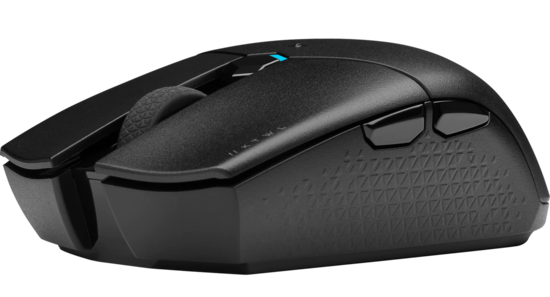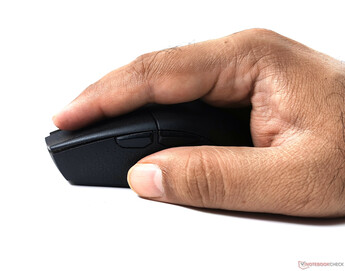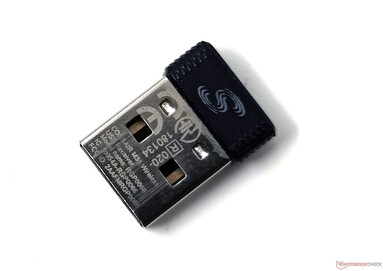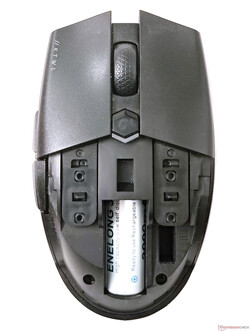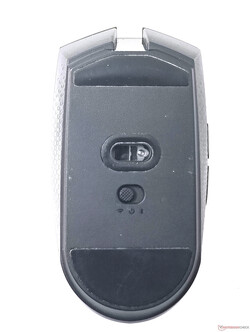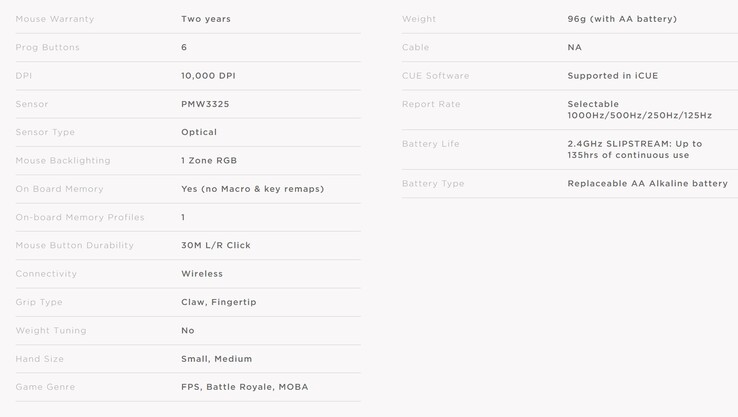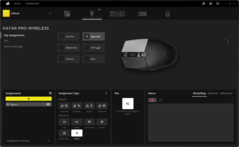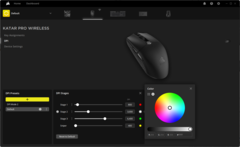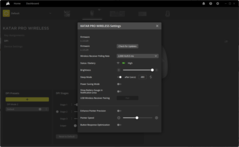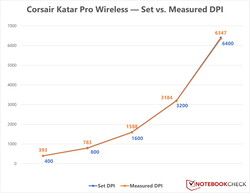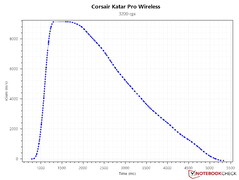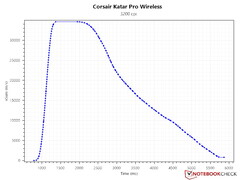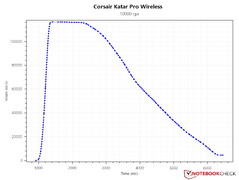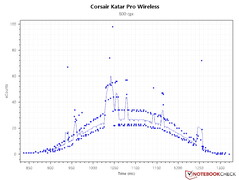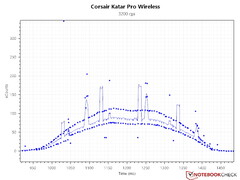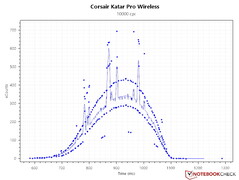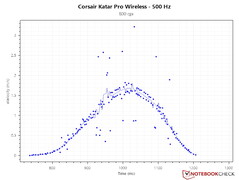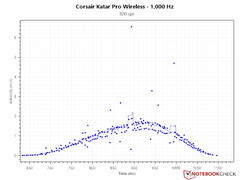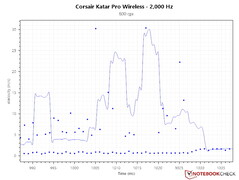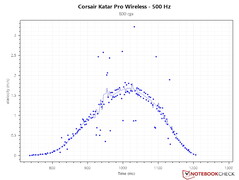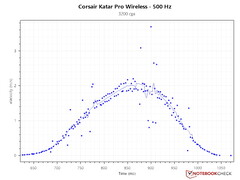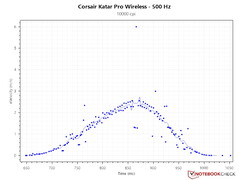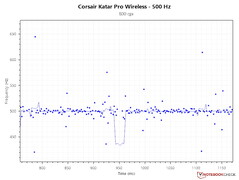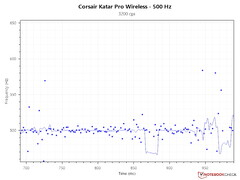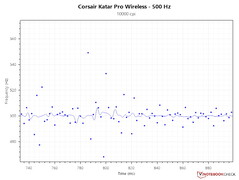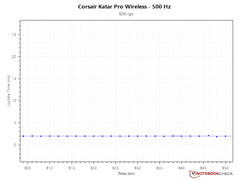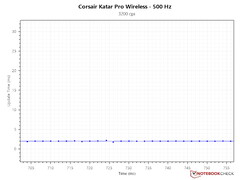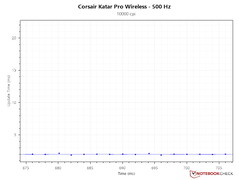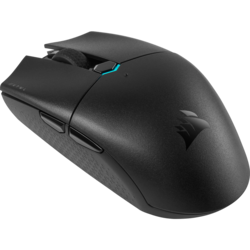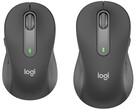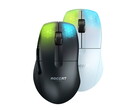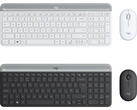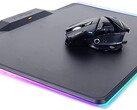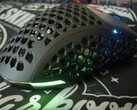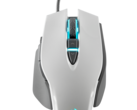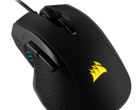Corsair Katar Pro Wireless Review: Decent performance despite cost and cord cutting
The Corsair Katar series mice are known for their adaptability to both claw and fingertip grip styles. So far, Corsair has offered the Katar Pro XT wired gaming mouse with an 18,000 DPI PMW3391 sensor — the same sensor found in more advanced mice such as the IronClaw RGB and the M65 RGB Elite. Now, Corsair is bringing the Katar design in a wireless format with the Katar Pro Wireless.
Unlike other Corsair wireless mice such as the Harpoon RGB, IronClaw RGB, and the M65 RGB Ultra that feature both wired and wireless connectivity, the new Katar Pro is a fully wireless gaming mouse that works on either Corsair's 2.4 GHz Slipstream wireless or Bluetooth. The mouse is powered by a single AA battery.
In this review, we take the Corsair Katar Pro wireless for a spin, and see how much of a performance you can expect for the current US$30 (₹3,499 in India) ask.
Design: Decent build quality suitable for claw and fingertip grips
The Katar Pro Wireless sports quite a bland design and does not exude any gamery vibes. The body is primarily made of plastic and is relatively light weight at just 96 g with the AA battery inside. There are no tunable weights available.
The top surface of the Katar Pro Wireless has a matte coating while the sides are textured for better grip. Most medium-sized hands will find the palms entirely covering the mouse body and the thumb resting completely on the two side buttons.
The mouse is amenable to both claw and fingertip grip styles. It is also suitable for ambidextrous use, but left-handers will miss out on the thumb click convenience for the side buttons.
A total of six programmable buttons are available — the left and right buttons, middle scroll wheel, two side buttons, and the DPI toggle switch. Corsair's iCUE software offers extensive programming options for each of these buttons. There is no dedicated Sniper button, but you can set a separate DPI for sniper functions.
The buttons are quite responsive, particularly the side ones, which you may find yourself inadvertently clicking with your thumb at times.
The DPI switch feels slightly stiffer compared to the other buttons while the scroll wheel click is the stiffest with a high actuation force.
There is no RGB lighting of any sort. The only lighting you get is a brief DPI indicator, the color of which can be customized from within iCUE.
At the bottom, we find two mouse feet — at the top and bottom each. The mouse feet need not be removed if you ever plan on disassembling the mouse, which is a good thing. You also get to see the window for the PMW3325 sensor and a switch that lets you select between Wi-Fi, off, and Bluetooth modes.
Overall, the Katar Pro Wireless has a decent build quality for the price with little room for complaints.
Specifications: A cut-down Katar Pro XT that is fully wireless
The Katar Pro Wireless features largely the same specifications as those of the Katar Pro XT. However, Corsair has cut some corners with the wireless version. While the Katar Pro XT features the high-end custom PixArt PMW3391 sensor, the Katar Pro Wireless makes do with a PMW3325. PixArt's official specifications rate the PMW3325 at up to 5,000 CPI resolution, but Corsair's implementation seems to enable up to 10,000 CPI.
The PWM3325 consumes just about 6.70 mA average power when in use, making it ideal for wireless use on battery power. However, the PMW3325 is starting to show its age as was evident by the delayed wake-up from Corsair's power-saving mode in our testing.
The Katar Pro Wireless offers 800, 1,500, and 3,000 DPI modes in the default configuration along with a Sniper DPI of 400. Unlike the PMW3391 sensor that allows a 1 DPI increment, the PMW3325 allows DPI changes only in increments of 100. You can set it at up to 200 DPI at the low end and up to a 10,000 DPI maximum.
Also, unlike the Katar Pro XT, the Katar Pro Wireless offers a somewhat reduced switch life at a 30 million clicks rating for the left and right mouse Kailh switches. The mouse can work on both 2.4 GHz slipstream wireless as well as on Bluetooth.
The polling rate originally maxed-out at 1,000 Hz/1 ms, but the latest firmware enables polling rates up to 2,000 Hz/0.5 ms. The mouse drops to 125 Hz/8 ms when in power saving mode. We used 2,000 Hz and 500 Hz polling rates for testing for reasons explained in the Sensor Performance section.
Software: Basic adjustments only
Out-of-the-box, the Katar Pro Wireless does not need any software to run. It gets immediately recognized in Windows whether via the supplied Wi-Fi dongle or via Bluetooth. You can still make use of Corsair iCUE for any configuration changes, but the Katar Pro Wireless lends itself to just basic customization.
With iCUE 4.22, you can remap or assign custom functions to each of the six mouse buttons, set custom DPIs and corresponding LED color indications, update the firmware, and configure Sleep Mode and Power Saving Mode settings. There is no scope for adjusting lift-off distance, angle snapping, and surface calibration.
You do get a battery level indicator, but it is arbitrary and only mentions "High" or "Low" without giving a percentage estimate.
Sensor Performance: Erratic performance at 2,000 Hz polling
We evaluated several key parameters of the Corsair Katar Pro Wireless's PMW3325 sensor to get an idea of its overall performance and accuracy. Our test bed rocks an AMD Ryzen 9 5950X processor, a Zotac AMP Extreme Holo GeForce RTX 3090 Ti GPU (because, why not?), and 32 GB of G.SKILL DDR4-3600 CL16 RAM running on an MSI Prestige X570 Creation motherboard. Windows 11 21H2 with the latest patches was the OS of choice installed on a Sabrent Rocket 4 Plus 2 TB PCIe Gen4 SSD.
MouseTester Reloaded v1.5.3 developed by dobragab was used for recording all sensor readings. In the Windows mouse settings, "Enhance pointer precision" was disabled and speed was set to 6/11. There is no option to disable angle snapping in iCUE. The latest available firmware (v2.5.29) was used for testing, and the poll rate was initially set to 2,000 Hz.
However, as we shall find out soon, the mouse does not perform well at such high polling rates.
The Katar Pro Wireless does not allow for surface calibration or configuring the lift-off distance. Therefore, we used Corsair's MM350 Premium Gaming Mouse Pad - Extended XL (930 mm x 400 mm) as the mouse pad of choice since it is likely that the mouse may have been factory-calibrated to a similar surface.
Do note that your own model can show slight variations in these results depending on how you do the measurement and on firmware improvements.
DPI variance
More often than not, the mouse's sensor does not attain the specified DPI in practice. This could be due to various reasons including quality of the sensor and optics, firmware, etc. We measured DPI variation in the Katar Pro Wireless with MouseTester Reloaded by moving the mouse at a constant pace over a fixed 10 cm distance. The readings were taken in triplicate and averaged.
The Katar Pro Wireless shows very good performance here with minimal DPI variance. In our testing, we found the DPI values to vary anywhere between 0.5% (3,200 DPI) to 2.14% (800 DPI), which is not too shabby.
Corsair markets the Katar Pro Wireless as a gaming mouse, and 800 DPI is a commonly preferred setting among most gamers. Therefore, it would have been ideal if the DPI variance had been much lower in this setting. Still, the Katar Pro Wireless should hold well for the vast majority of use cases including gaming unless you are too picky about sensitivity.
Speed-related accuracy variance (SRAV)
We measured all sensor parameters at 800 DPI (gaming), 3,200 DPI (desktop use), and 10,000 DPI (sensor maximum) resolutions. Speed-related accuracy variance (SRAV) tells us whether the mouse has any inherent sensor acceleration that can otherwise adversely affect gaming performance. High SRAV is not ideal as the movement of the character on screen would then not be a true representation of the physical speed of the mouse over a defined distance on a known surface.
The Katar Pro Wireless does not seem to show high SRAV when accelerated and slowly decelerated back to origin as evident from the plots below. Any slight displacement seen is likely due to human error and not the sensor itself.
Sensor counts
Sensor counts tell us how well the sensor is able to record raw data without losing tracking, and this test shows that the PMW3325 is starting to show its age. Sensor tracking at the tested DPIs at 2.000 Hz is decent, though we find that the counts tend to drift away from the central curve when the sensor starts recording more data. The divergence is seen to be the highest at 10,000 DPI.
Better tracking should be possible at lower polling rates.
Perfect Control Speed (PCS)
So far, the 2,000 Hz polling rate did not pose much of a real issue. However, we find erratic perfect control speed (PCS) performance at 2,000 Hz. PCS is an important parameter as it tells how fast the user can move the mouse without the sensor losing tracking. The PMW3325 is generally known to track well at about 2-4 m/s. However, it is simply not designed to perform great at polling rates above 1,000 Hz.
A comparison of PCS at 500 Hz, 1,000 Hz, and 2,000 Hz polling rates at 800 DPI as shown in the graphs below should give a better idea.
Polling rate and Update interval stability
We observe the Katar Pro Wireless decent polling at 500 Hz. There are many outliers seen in the graphs, but we observed that the performance at 500 Hz is much better than at other frequencies. The polling rate at 2,000 Hz wasn't in the least bit consistent, so we suggest avoiding it.
Nevertheless, setting a lower poll rate also has an added advantage of lower battery drain in both the mouse and the paired laptop. In practical usage, you will not notice any difference in usability between 500 Hz and 2,000 Hz polling rates.
Verdict: Decent performance despite the handicaps
The Corsair Katar Pro Wireless is a decent product overall. For the currently discounted retail price of US$30 (₹3,499 in India), you get a wireless mouse that strictly performs according to specifications with no room for any pleasant surprises. Corsair markets the Katar Pro Wireless as a gaming mouse, but our testing found some deficiencies majorly due to the decade-old sensor.
The Katar Pro Wireless is light and built well for most regular use, although the plastic construction does not inspire a lot of confidence at first sight. Like its wired cousin, the Katar Pro XT, the Katar Pro Wireless is also fully amenable to both claw and fingertip grip styles. Left handers can use the mouse comfortably as well provided they can somehow make do without the side thumb buttons. Button placement is good and the tactility is decent. There is no lighting of any kind on the mouse save for the DPI switch.
The Katar Pro Wireless is a fully wireless mouse that would appeal for both productivity and casual gaming. It is well-designed and lightweight but is handicapped by an ageing sensor, which Corsair tries to push beyond its abilities.
The Katar Pro Wireless cuts several corners when compared to the Katar Pro XT with the main Achilles' heel being the sensor. The PMW3325 is now a decade-old part and while it suits the purpose of the mouse just fine for regular use, it falls short of the competition who have all graduated to better tracking sensors and faster wake-up times from standby. Most users, however, will not notice shortcomings in sensor performance in regular use.
Corsair tries to push the ageing sensor further by offering high polling rates up to 2,000 Hz and DPI settings up to 10,000. As seen in our test results, the sensor is not capable of operating well at such high polling rates requiring us to drop down to 500 Hz for acceptable performance. Such high polling rates also have a negative effect on the battery life of both the mouse and a laptop device as well.
While a wireless mouse can be liberating, the Katar Pro Wireless is completely sans wired connectivity so any damage or loss of the dongle will mean that you will be stuck with Bluetooth or a paperweight.
If you aren't really picky about going full wireless and need the versatility in grip styles, the Katar Pro XT makes for a better choice. It uses the more advanced PMW3391 sensor and retails for basically the same price as the wireless version. On the other hand, the Corsair Harpoon Wireless may be a worthy consideration at a similar place if a hybrid mouse sounds more appealing.
Disclaimer: The author has received the Corsair Katar Pro Wireless gaming mouse free of charge for the purposes of testing and review.
Pricing and Availability
The Corsair Katar Pro Wireless is now available at a discounted price of US$30 on Corsair.com and Amazon.com. In India, the wireless mouse is currently available on Amazon.in at a discounted price of ₹3,499.


 Deutsch
Deutsch English
English Español
Español Français
Français Italiano
Italiano Nederlands
Nederlands Polski
Polski Português
Português Русский
Русский Türkçe
Türkçe Svenska
Svenska Chinese
Chinese Magyar
Magyar